617 Search Results for tell me about it
April 18, 2019
by Carole Zangari -
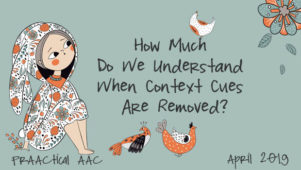
Have you ever worked with clients who could benefit from AAC but resisted using it because they don’t realize that other people can’t understand their speech? Or a family who resists AAC because they perceive their loved one as intelligible when they are actually depending on the context to help them decipher the message? Have you ever worked with service providers who disagree on just how comprehensible their client’s natural speech really is? It doesn’t happen often, but there are occasions when it can be helpful to remove context cues from the mix and take a hard look at how well we understand someone’s natural speech. Formal testing may certainly play a role here, but informal assessment activities can also be helpful. Here is a task we sometimes use in these situations. The Materials Develop a list of 20 words and/or 20 sentences that will serve as the stimuli. For... [Read More...]
April 4, 2019
by Carole Zangari -
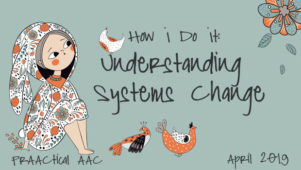
Have you ever dreamed of taking a detour in your AAC work to address the needs from a totally different direction? Special educator Sarah Mueller did just that. Follow along as she tells us about her journey from teacher to student. :::::::::::::::::::::::::::::::::::::::::::::::::::::::::::::::::::::::::::::::::::::::::::::::::: “Autism isn’t something a person has or a ‘shell’ that a person is trapped inside. There’s no normal child hidden behind the autism. Autism is a way of being. It is pervasive; it colors every experience, every sensation, perception, thought, emotion, and encounter, every aspect of existence. It is not possible to separate the autism from the person – and if it were possible, the person you’d have left would not be the same person you started with. This is important, so take a moment to consider it: Autism is a way of being. It is not possible to separate the person from the autism.” – Jim Sinclair... [Read More...]
March 25, 2019
by Carole Zangari -
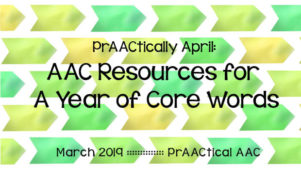
It’s almost time to turn the calendar to a new page and that gives us the opportunity to highlight a new set of core words. Whether you are following along with the Set 1 (12 words/month) or the Set 2 words (16 words/month; Different than the previous core words), or are just getting started, this post has some helpful resources. We’re grateful to Nancy Inman, Brian Whitmer, Tina Lombardi, Barbara Fernandes, Russell Cross, Gail Van Tatenhove, Allison Wade, Eric Sailers, Bill and Lori Binko, Heidi LoStracco, Rachael Langley, and all the others who have contributed to this effort. Our words for this month are as follows. Set 1 List: big, busy, do, drink, feel, he, in, make, out, some, tell, who Set 2 List: blue, brother, close, family, head, last, long, no, old, right, scared, soft, thing, top, wash, whole Here are some resources to help with implementation. Templates for you to plug... [Read More...]
March 21, 2019
by Carole Zangari -
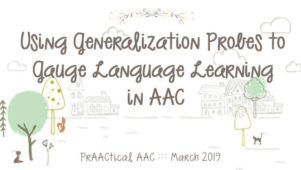
In her role as the team’s SLP, Christy frequently collaborates with classroom teachers to identify areas of language development where students learning AAC need specific goals and instruction. Goals for her students address a range of areas. Given frequent aided language input, Evan will use 2-symbol sentences to make relevant comments at least twice per activity. When presented with preferred and non-preferred options, Sasha will independently request desired activities/objects with 70% accuracy. In the context of peer interactions, Tegan will ask a ‘What’ question in 3 out of 5 opportunities. Given gestural cues, Matthew will converse on a partner-selected topic for at least 4 conversational turns. With visual supports, Gabby will use subject + verb sentences to describe pictures, materials or events in 4 out of 6 trials. To help the students acquire these skills, Christy carefully plans the instructional sequence and selects contexts appropriate for the intervention targets. She... [Read More...]
March 11, 2019
by Carole Zangari -
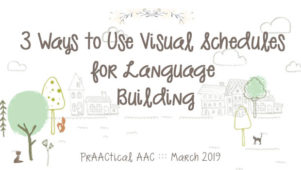
Visual schedules are powerful tools for supporting comprehension, reducing anxiety, and helping learners with AAC needs become more independent. They can also be used to build receptive and expressive language. To do that, though, the use of daily or mini/task schedules has to be part of an interactive experience, not an independent activity. If you’re willing to use schedules for language building, here are some ideas to consider incorporating. Sentence Building: This is an easy one. If you are working with an AAC learner who communicates primarily with one word/symbol at a time, slow down and take time to model short sentences every time you check the schedule together by adding a verb (e.g., GO to LifeSkills; EAT lunch, PUT AWAY your backpack). Once you’ve established that routine, you can pause to elicit those same sorts of sentences from the AAC learner. Verb Tense: As you use the schedule... [Read More...]
February 21, 2019
by Carole Zangari -
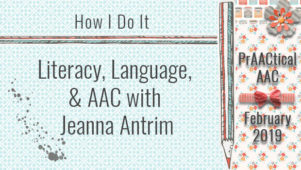
We have deep respect for clinicians and educators who are willing to share their approach to developing strong AAC instructional sessions. Today, we are excited to welcome SLP Jeanna Antrim to these pages. Jeanna has been an SLP for the past 7 years practicing at special education cooperatives in southern Illinois. She works both with students in a self-contained behavior school and as an AAC facilitator conducting AAC evaluations, providing direct therapy, and consulting with school teams. In this post, she shares her approach to developing AAC sessions using shared reading. (Don’t miss her book packet and handouts.) ::::::::::::::::::::::::::::::::::::::::::::::::::::::::::::::::::::::::::::::::::::::::::::::::::::::: How I Do It: Literacy, Language, and AAC After graduating, it took me a few years of trial and error before I figured out (and don’t get me wrong I’m still figuring out) my niche. I absolutely love books and love how I can target any language and communication concept within a... [Read More...]
February 7, 2019
by Carole Zangari -
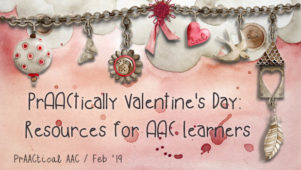
As our thoughts turn to Valentine’s Day, we polished up one of Robin’s old posts with lots of resources to explore. Enjoy! ——————————————————————————————————————— Valentine’s Day is a theme that seems to take center stage in February. When we use this theme, we like to focus on it before, during, and after February 14th because then there are a lot of opportunities to talk about it before, during, and after the holiday. This is like a conversation which involves so much more than talking about the ‘here & now’. Core Vocabulary Activities: Check out these fun ideas from teachers and clinicians. Use Candy Heart Generators and Word Clouds Create your own digital candy hearts with your own text with CryptoGram. Word clouds are a fun way to integrate a theme. You can read more about how to use them in AAC lessons here and here. You can also insert your own Valentine’s Day... [Read More...]
February 4, 2019
by Carole Zangari -
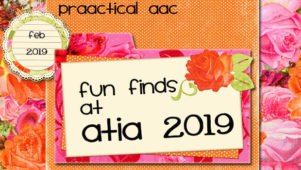
As expected, the ATIA Conference in Orlando last week had a robust selection of AAC learning opportunities. Here are two of the fun finds we thought you’d like to explore. The AAC Strand Spotlight Session This panel asked four thought leaders in AAC to each identify two intervention challenges and discuss their ideas for addressing them. The speakers were from a variety of practice settings and addressed a range of implementation issues. Christopher Bugaj, AAC and AT Specialist at Loudoun County Public Schools Transitions & Turnovers: Killers of Language Learning Progression Keeping Up With The Training Demand Vicki Clarke, SLP/CEO, Dynamic Therapy Associates, Inc. Addressing Opportunity Barriers to Participation Facilitator Attitude, Knowledge, & Skill Barriers Caroline Musselwhite, Literacy & AAC Specialist Facilitating Generalization Age-Respectful and Engaging Materials/Activities for Adolescents & Teens Gail VanTatenhove, SLP/CEO, AACell, Inc. Providing Person-Specific AAC Design in an App/MAP Happy World The Aging of AAC Users... [Read More...]
January 28, 2019
by Carole Zangari -
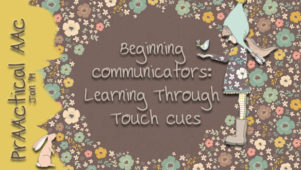
15-year-old Jodi has cerebral palsy and significant intellectual disability, among other things. In the most recent assessment of her motor, cognitive, communication, and self-help skills, scores ranged from 6-15 months. She spends most of her school day in her wheelchair. Jodi’s teacher affixes interesting toys to the lap tray so that she can explore them, but has become discouraged that Jodi mostly bangs them, puts them in her mouth, or tosses them to the floor. Her team struggles to find ways to teach Jodi to communicate more effectively. 10-year-old Nathaniel’s team notes that he shows little awareness of his classmates or teachers throughout the day, though he will smile and laugh when they take his hands and clap with him. As a younger child, he demonstrated more awareness of his surroundings but after his seizure activity spiked, it became more and more difficult to get him to engage. 6-year-old Jarrod... [Read More...]
December 17, 2018
by Carole Zangari -

We’re so pleased to welcome back Sarah Mueller, who teaches high school students with intellectual and developmental disabilities in Rochester, Michigan. In this post, she shares her experiences in working with peer mentors and how she has helped to facilitate meaningful relationships between students with and without disabilities. Don’t miss her video or the links to download some of the materials they used. Enjoy! The Power of Peers We often talk about the functions of communication and their importance in developing and expanding the students’ communicative repertoire. Moving beyond requesting to protesting, commenting, and greeting and other functions is often the focus. But as high schoolers included in the school community, my students want to be social with their peers without disabilities. What does that look like for students with complex communication needs? How, as a teacher, can you structure social opportunities to teach and practice core? What... [Read More...]









